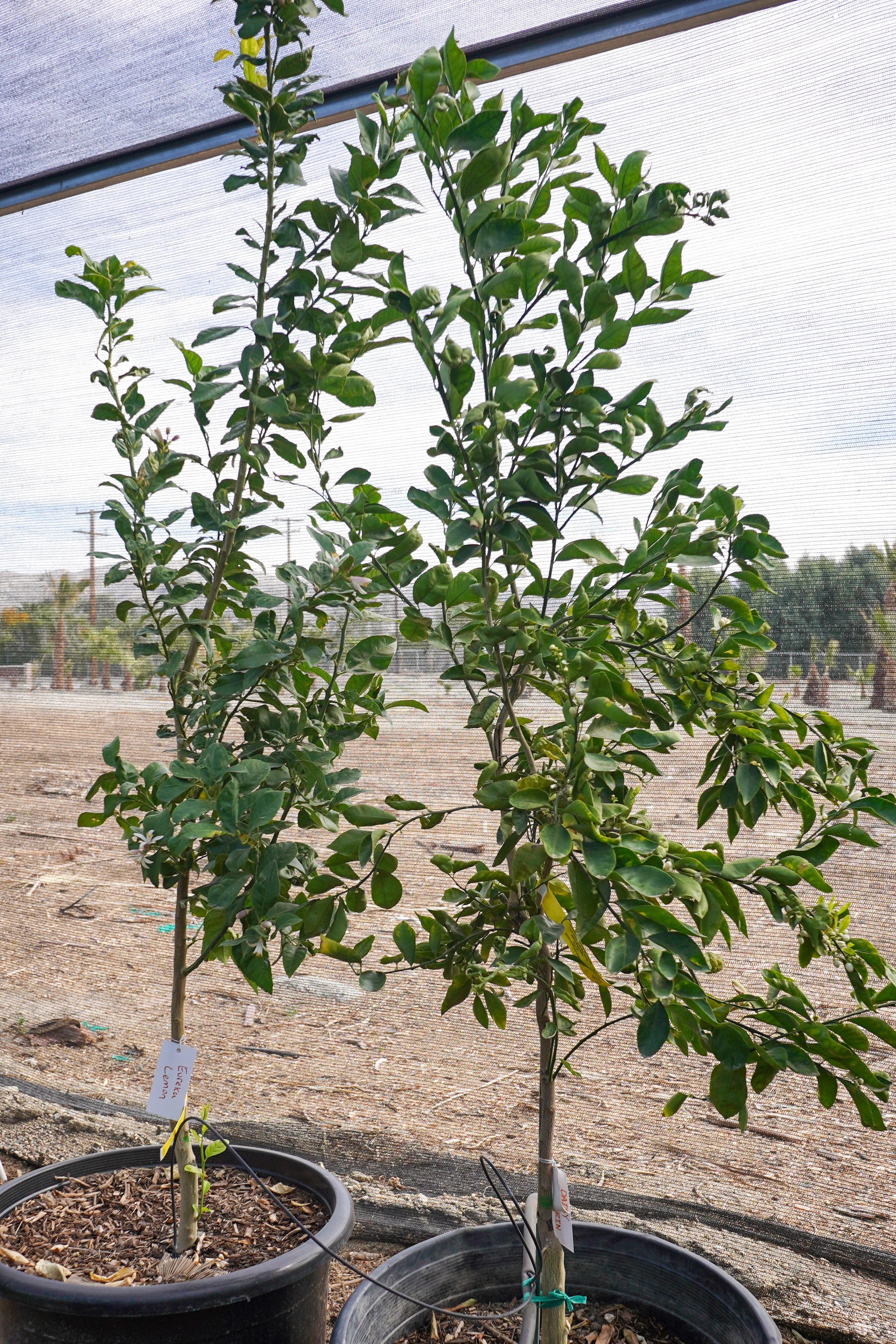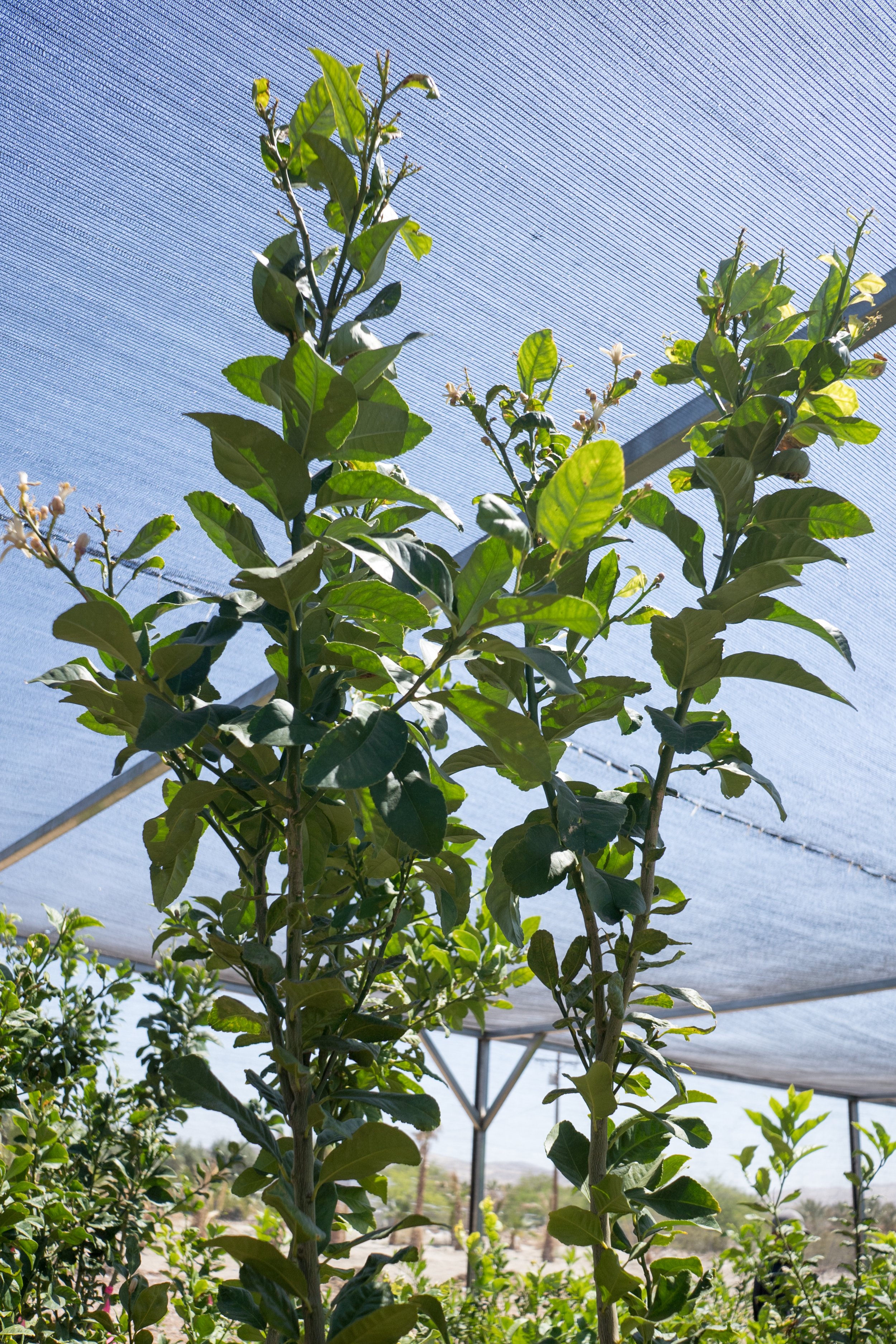Eureka Lemon Tree
Intense perfume, refreshing lemons, and enduring deep green leaves make for a very attractive and useful tree.
So what are some qualities that set the Eureka lemon tree apart?
Few thorns, few seeds, and a familiar tart taste, just to name a few. Read on to learn more about this plant that quickly became one of the most popular lemon trees in the US.
Botanical name: Citrus x Limon 'Eureka'
Other names: Eureka tree, Garey's Eureka tree
Eureka lemon trees for sale at our nursery
TABLE OF CONTENTS
Eureka lemon tree Appearance
Beautiful evergreen tree with deep green leaves. Good small to a medium-sized shade tree.
Will grow to 20 feet in height, although many people regularly prune it so that it stays to around 10 feet. The spread is about 4 feet wide.
White blooms with an intense and pleasant fragrance, followed by green lemons that turn yellow as they ripen.
Oblong lemons have thick skin and relatively few seeds.
Easy lemon harvest due to 1. short branches with 2. few thorns or none at all. Also, 3. the lemons grow on the outer parts of the tree.
Eureka lemon tree Landscaping Tips
Brings a sense of elegance and tranquility to the garden.
The heaviest blooms in spring attract bees and hummingbirds. In many warm regions, lemons appear year-round. Provide fertilizer and more water when flowering and fruiting.
Lemon trees are self-pollinating, so only one tree is required for producing lemons.
Eureka lemon tree reaches maturity in about 3 years. Once mature, it performs well in the heat as long as they get enough water.
Harvest lemons when they are yellow.
Prune weak or diseased branches throughout the year. The heaviest pruning should be done in late winter to keep lemon trees at a manageable size.
Performs well in containers, although it will require more watering.
Eureka lemon tree Origin
Los Angeles, CA, which enjoys warm and temperate weather year round. Evolved from a different lemon tree brought in from Italy.
Eureka lemon tree Care
Soil: Fertile, well-draining soil that is slightly acidic to acidic
Temperature: Can withstand temperatures down to 20 degrees for a short period of time.
Water: Moderate water needs. Regular deep watering, especially when blooming and fruiting and during heatwaves. Do not allow soil the completely dry out for a long period of time. More drought tolerant once mature.
Sun: Full sun
Eureka lemon tree Problems
Pests: Eureka lemon trees may attract pests such as aphids, mealybugs, and scale.
For aphids, blast them off with water if the infestation is light. Otherwise, use horticultural oil or soapy water.
To remove mealybugs, use insecticidal soap or apply rubbing alcohol directly to the area of the infestation using a cotton swab.
To remove scales, pick them off or use horticultural oil or insecticidal soap. Horticultural oil will kill both crawlers and adults with direct contact. Insecticidal soap is better used to target only the crawlers.
Whenever using any kind of pesticide, be aware that it can damage the plant if the temperatures are in the 80s or above.
Signs of overwatering: Root rot, drooping leaves
Signs of too little water: Browning and drying leaves
Signs of too much sun: Leaf burn, fading color
Signs of too little sun: Etiolation, stunted growth, few flowers
Eureka lemon tree Propagation
The easiest way to propagate a Eureka lemon tree is through cuttings. Obtain 1-foot-long semi-hardwood cuttings with a sharp tool and plant them in the soil. Keep soil moist until it's well established.
FAQ
HOW MUCH DOES a Eureka lemon tree COST?
At our nursery, Eureka lemon trees cost $150 for a 15-gallon container and $325 for a 24” box.
Prices are subject to change. Please contact us for the most up-to-date information on pricing. We may have larger sizes available. We provide installation services locally at a separate cost.
What do Eureka lemons taste like?
Eureka lemons are very flavorful and tart. You've probably had them before either from a restaurant or grocery store. Very common and popular here in the US. Overall, it has a juicy and refreshing taste.
The peels are tangy and make for great lemon zest.
Why should I get a Eureka lemon tree over other lemon trees?
Advantages that Eureka lemon trees have are abundant crops, few thorns, and lemons that grow outwards rather than deep within the tree. The lemons are very flavorful and sour and are not full of many seeds. Finally, the Eureka lemons have good storage.
How big does a Eureka lemon tree get?
It will grow to 20 feet, although many people keep the tree pruned so that it stays to around 10 feet. The spread is about 4 feet wide.
Can I get lemons from one Eureka tree?
Yes, lemon trees are self-pollinating. One blossom contains both male and female parts to allow self-pollination.
How long does it take for a Eureka lemon tree to bear fruit?
Most lemon trees start to bear fruit when they're about 3 years old.
Summary
| SIZE (H X W) | 20 feet X 4 feet |
|---|---|
| FLOWER COLOR | White |
| FLOWER SEASON | Spring to Fall |
| EXPOSURE | Full Sun |
| WATER | Moderate |
| GROWTH RATE | Moderate to Fast |
| HARDINESS | 20º F, USDA Zone 9 |
| PRUNING | As needed |



